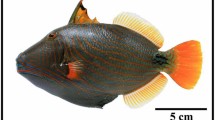Abstract
C-banding and fluorescence in situ hybridization (FISH) document the distribution of constitutive heterochromatin and six highly repeated DNA families (MSAT2570, MSAT21, MSAT160, MS2, MS4 and STR47) in the chromosomes of nine species of Microtus (M. chrotorrhinus, M. rossiaemeridionalis, M. arvalis, M. ilaeus, M. transcaspicus, M. cabrerae, M. pennsylvanicus, M. miurus and M. ochrogaster). Autosomal heterochromatin is largely centromeric and contains different repeated families in different species. Similarly, large C-band positive blocks on the sex chromosomes of four species contain different repeated DNAs. This interspecific variation in the chromosomal distribution and copy number of the repeats suggests that a common ancestor to modern species contained most of the repetitive families, and that descendant species selectively amplified or deleted different repeats on different chromosomes.
Similar content being viewed by others
References
Burgos M, Jimenez R, Diaz de la Guardia R (1988a) Comparative study of G-and C-banded chromosomes of five species of Microtidae: a chromosomal evolution analysis. Genome 30: 540–546.
Burgos M, Jimenez R, Olmos DM, Diaz de la Guardia R (1988b) Heterogeneous heterochromatin and size variation in the sex chromosomes of Microtus cabrerae. Cytogenet Cell Genet 47: 75–79.
Chaline J (1974) Esquisse de l'evolutionmorphologique, biometrique, et chromosique du genre Microtus (Arvicolidae, Rodentia) dansle Pleistocene de l'hemisphere nord. Bull Soc Geol Fr 16: 440–450.
Conroy CJ, Cook JA (2000) Molecular systematics of a holarctic rodent (Microtus: Muridae). J Mammal 81: 344–359.
Elisaphenko EA, Nesterova TB, Duthie SM et al. (1998) Repetitive DNA sequences in the common vole: cloning, characterization and chromosome localization of two novel complex repeatsMS 3 and MS4 from the genome of the East European vole Microtus rossiaemeridionalis. Chromosome Res 6: 351–360.
Gamperl R, Ehmann C, Bachmann K (1982) Genome size and heterochromatin variation in rodents. Genetica 58: 199–212.
Graf J-D (1982) Géné tique biochimique, zoogéographie et taxonomie des Arvicolidae (Mammalia, Rodentia):. Rev Suisse Zool 89: 749–787.
Graphodatsky AS, Lushnikova TP, Radzhabli SI (1985) Interesting features of the distribution of repeated DNA sequences in the XY chromosomes of four rodent species. Tsitologiya 27: 1308–1310 (in Russian).
Hoffmann RS, Koeppl JW (1985). Zoogeography. In: Tamarin RH, ed. Biology of NewWorld Microtus. Special Publication, The American Society of Mammalogists, pp 84–115.
Ivanov SV, Modi WS (1996) Molecular characterization of the complex sex-chromosome heterochromatin in the rodent Microtus chrotorrhinus. Cytogenet Cell Genet 75: 49–56.
Kalscheuer V, Singh AP, Nanda I, Sperling K, Neitzel H (1996) Evolution of the gonosomal heterochromatin of Microtus agrestis: rapid amplification of a large, multimeric, repeat unit containing a 3.0-kb (GATA)11-positive, middle repetitive element. Cytogenet Cell Genet 73: 171–178.
Khrapov EA, Elisaphenko EA, Rogozin IB et al. (1998) Feature and possible origin of the new tandem STR47 repeat in grey voles. Mol Biol 32: 987–991 (in Russian).
Lawrence JB, Villnave CA, Singer RH (1988) Sensitive, high-resolution chromatin and chromosome mapping in situ: presence and orientation of two closely integrated copies of EBV in a lymphoma line. Cell 52: 51–61.
Mayorov VI, Adkison LR, Vorobyeva NV et al. (1996) Organization and chromosomal localization of a B1-like containing repeat of Microtus subarvalis. Mamm Genome 7: 593–597.
Meyer MN, Golenishchev FN, Radjabli SI, Sablina OV (1996) Voles (Subgenus Microtus Schrank) of Russia and Ajacent Territories. Russian Academy of Sciences, Proceedings of the Zoological Institute 232: 3–320 (in Russian).
Modi WS (1987a) C-banding analyses and the evolution of heterochromatin among arvicolid rodents. J Mammal 68: 704–714.
Modi WS (1987b) Phylogenetic analyses of the chromosomal banding patterns among the Nearctic Arvicolidae. Systemat Zool 36: 109–136.
Modi WS (1992) Nucleotide sequence and genomic organization of a tandem satellite array from the rock vole Microtus chrotorrhinus (Rodentia). Mamm Genome 3: 226–232.
Modi WS (1993a) Comparative analyses of heterochromatin in Microtus: sequence heterogeneity and localized expansion and contraction of satellite DNA arrays. Cytogenet Cell Genet 62: 142–148.
Modi WS (1993b) Heterogeneity in the concerted evolution process of a tandem satellite array in meadow mice (Microtus). J Mol Evol 37: 48–56.
Modi WS (1993c) Rapid, localized amplification of a unique satellite DNA family in the rodent Microtus chrotorrhinus. Chromosoma 102: 484–490.
Modi WS (1996) Phylogenetic history of LINE-1 among arvicolid rodents. Mol Biol Evol 13: 633–641.
Pinkel D, Straume T, Gray JW (1986) Cytogenetic analysis using quantitative, high-sensitivity, £uorescence hybridization. Proc Natl Acad Sci USA 83: 2934–2938.
Repenning CA (1980) Faunal exchangesbe tween Siberia and North America. Can J Anthropol 1: 37–44.
Shevchenko AT, Mazurok NA, Slobodyanyuk SY, Zakian SM (2002) Comparative analysis of the MSAT-160 repeats in four species of common vole (Microtus, Arvicolidae). Chromosome Res 10: 117–126.
Sperling K, Kalscheuer V, Kottusch-Geisler V, Neitzel H (1990) Genetic activity of constitutive heterochromatin in mammals. Chromosomes Today 10: 83–89.
Sumner AT (1972) A simple technique for demonstrating centromeric heterochromatin. Exp Cell Res 75: 304–306.
Author information
Authors and Affiliations
Rights and permissions
About this article
Cite this article
Modi, W.S., Serdyukova, N.A., Vorobieva, N.V. et al. Chromosomal localization of six repeated DNA sequences among species of Microtus (Rodentia). Chromosome Res 11, 705–713 (2003). https://doi.org/10.1023/A:1025922813756
Issue Date:
DOI: https://doi.org/10.1023/A:1025922813756




